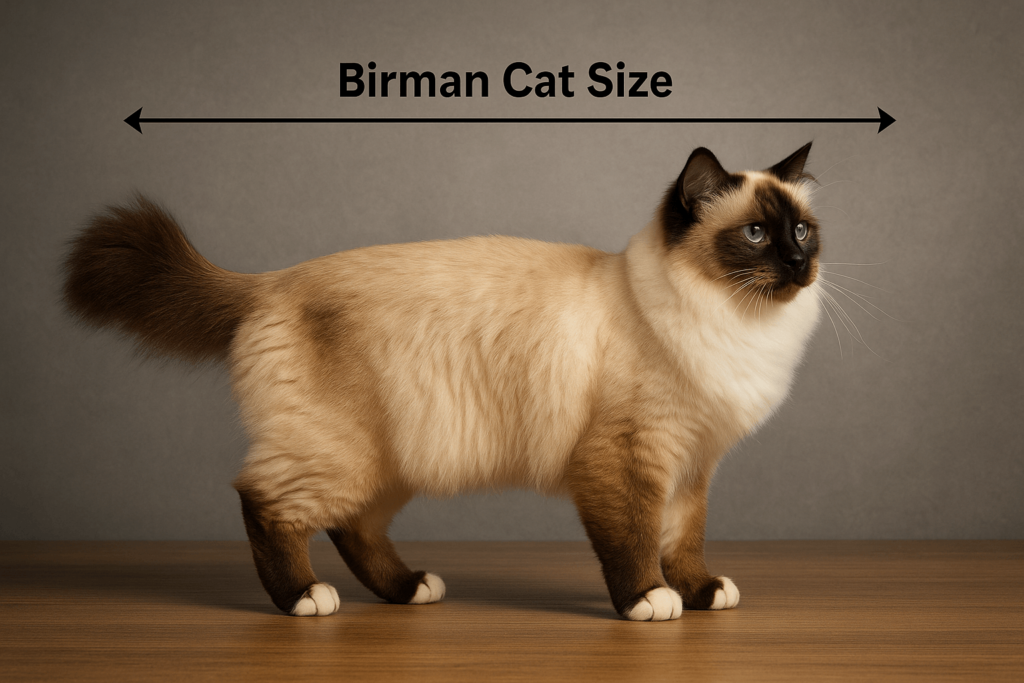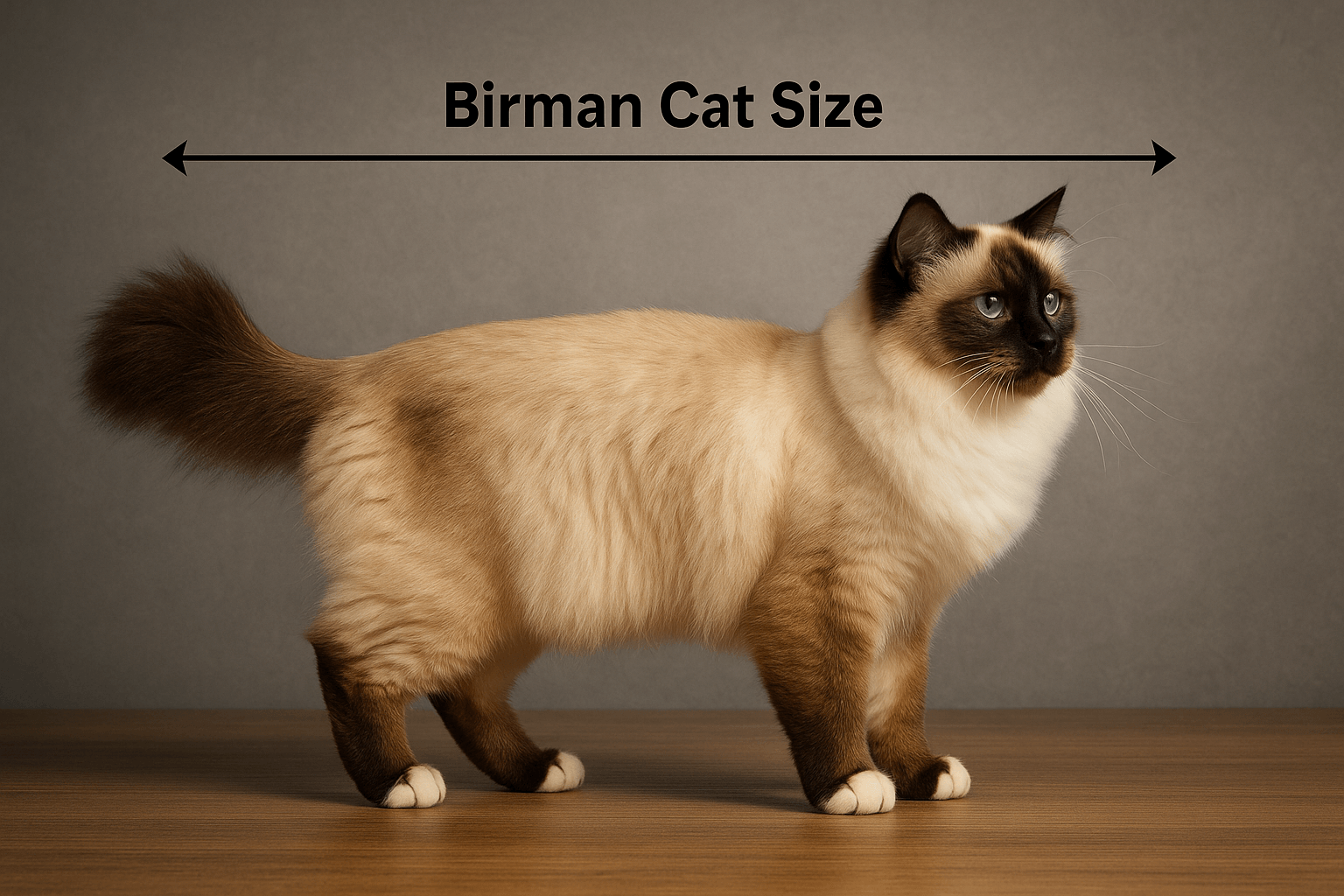Birman Cat Size: Understanding the Elegant Build of a Sacred Breed
The Birman cat is a vision of grace—soft-eyed, silken-furred, and subtly muscular. Known for their striking blue eyes and pointed coloration, Birmans are often admired for their beauty, but their size is just as telling as their appearance. Unlike the slender Siamese or the bulky Maine Coon, the Birman carries a medium-to-large frame with a deliberate, balanced weight that speaks of strength beneath serenity. Understanding Birman cat size isn’t just about numbers—it’s about appreciating how their physique reflects their history, temperament, and health. In this guide, we explore everything you need to know about their build, growth patterns, and what to expect when welcoming a Birman into your home.
What Defines a Birman’s Size?
A Birman’s size isn’t random—it’s the result of centuries of selective breeding for harmony, not exaggeration. Their build is neither too delicate nor too heavy, but perfectly proportioned for their noble lineage. Here’s what makes their dimensions unique:
Medium to Large Frame:
Birmans are classified as medium-to-large cats, with a solid, muscular body that feels heavier than it looks due to dense fur and bone structure.Weight Range for Adults:
Adult males typically weigh between 4.5 to 6.8 kg (10 to 15 lbs), while females range from 3.6 to 5.4 kg (8 to 12 lbs).Slow Maturation:
Unlike many breeds that reach full size by age 1–2, Birmans take up to 3–4 years to fully develop their size and coat.Bone Structure and Musculature:
They have a sturdy, cobby body with well-developed shoulders and hindquarters—built for quiet strength, not speed.Proportional Length:
Their bodies are slightly longer than tall, giving them a graceful, elongated silhouette that enhances their elegant movement.
This isn’t a breed designed for extremes. The Birman’s size is a reflection of balance—elegant, yet substantial. When you hold one, you feel weight, warmth, and substance—not fluff or fragility.

How Birman Cat Size Compares to Other Popular Breeds
To truly understand the Birman’s stature, it helps to see how they stack up against other beloved breeds. Their size places them firmly in the middle ground—neither tiny nor giant, but perfectly poised.
Compared to Siamese:
Siamese cats are lean and slender, often weighing only 2.7 to 5.4 kg (6–12 lbs). Birmans are noticeably more robust and solid, even at the same weight.Compared to Ragdoll:
Ragdolls are larger and more laid-back, with males reaching up to 9 kg (20 lbs). Birmans are slightly more compact but equally plush in appearance.Compared to British Shorthair:
British Shorthairs are stockier and heavier-boned, often weighing more than Birmans. But Birmans carry their weight with more finesse and longer limbs.Compared to Maine Coon:
Maine Coons dwarf Birmans, sometimes exceeding 11 kg (25 lbs). Birmans are far more refined in structure, lacking the extreme size of this “gentle giant.”Compared to Persian:
Persians are compact and round, with dense fur adding bulk. Birmans are taller, more athletic, and their fur is silkier and less voluminous.
The Birman doesn’t seek to dominate space—it commands it with quiet dignity. Their size is ideal for families who want a cat that feels substantial without overwhelming a home.
Check this guide 👉Australian Feral Cat Size: Best 7 Expert Tips!
Check this guide 👉Himalayan Cat Size: Best 7 Expert Tips!
Check this guide 👉Bengal Cat Size: Best 7 Expert Tips!
| Birman Cat Size Feature | What It Means for You |
|---|---|
| Average Weight: 3.6–6.8 kg (8–15 lbs) | You’ll feel their presence—perfect for cuddling, but not too heavy for laps or furniture. |
| Height: 20–25 cm (8–10 in) at shoulder | Taller than most breeds, giving them a regal posture even when resting. |
| Length: 30–40 cm (12–16 in) body | Their elongated form makes them ideal for stretching out on beds or sofas. |
| Full Size Reached: 3–4 years | Patience is key—they grow slowly, so don’t assume a kitten’s size predicts their adult frame. |
| Body Type: Cobby with muscular build | They’re sturdy and balanced—great for active households, but not high-energy athletes. |
Growth Stages: How a Birman Kitten Becomes a Full-Grown Cat
Birman kittens are deceptively small at birth. Their true size emerges slowly, like a masterpiece painted in layers. Understanding their growth timeline helps you anticipate their needs.
Birth to 8 Weeks:
Newborn Birmans are tiny and fragile. By 8 weeks, they’ve doubled or tripled their birth weight but still look like fluffy balls with oversized paws.3 to 6 Months:
This is when their body begins to fill out. Legs lengthen, the tail thickens, and their signature color points become more defined.6 to 12 Months:
They gain muscle and bone density. Many owners mistake this phase for “being skinny”—but they’re just growing into their structure.1 to 2 Years:
Their coat reaches its full length and silkiness. Weight stabilizes, but they’re still developing subtle muscle tone and posture.2 to 4 Years:
True adulthood. Their body becomes solid, their frame broadens, and their overall presence becomes unmistakably Birman.
Don’t be fooled by a 6-month-old Birman who seems small. Their magic lies in patience. The real beauty unfolds after their second birthday.
Factors That Influence Birman Cat Size
Size isn’t just genetics—it’s shaped by environment, nutrition, and health. Several key factors determine how large your Birman will ultimately become.
Genetics and Lineage:
Cats from show-quality bloodlines tend to be larger and more structurally sound. Pet-quality kittens may be slightly smaller.Diet and Nutrition:
A high-protein, balanced diet during growth stages is essential. Poor nutrition can stunt development or lead to unhealthy weight gain.Spaying/Neutering Timing:
Early spaying or neutering (before 6 months) can delay growth plate closure, sometimes resulting in taller, leaner adults.Activity Level:
While not hyperactive, Birmans benefit from play and climbing. Lack of movement can lead to muscle loss and weight issues.Health Conditions:
Thyroid disorders, parasites, or digestive issues can impact growth. Regular vet checks ensure they’re developing properly.
Your Birman’s size is a reflection of the care they receive. Feed well, move often, and monitor closely—they’ll reward you with a perfectly balanced companion.
Signs Your Birman Is Underweight or Overweight
Even within the ideal size range, a Birman can be too thin or too heavy. Recognizing the difference is vital for their long-term health.
Underweight Signs:
Visible ribs or spine, lack of muscle tone along the back, dull coat, and lethargy. Often linked to dental pain or illness.Overweight Signs:
No waistline when viewed from above, difficulty grooming the hindquarters, heavy breathing after light activity, and reluctance to jump.Ideal Body Condition:
You should feel their ribs with light pressure—not see them, but not be unable to feel them. A slight tuck at the abdomen is normal.Coat Texture as a Clue:
Underweight cats often have sparse, brittle fur. Overweight cats may develop greasy patches or matting under the arms.Behavioral Clues:
A cat that sleeps excessively or avoids play may be struggling with weight. A cat that’s always hungry but thin may have an underlying condition.
A Birman’s beauty lies in balance. Too little, and they look fragile. Too much, and they lose their elegance. Aim for harmony—not extremes.
How Birman Size Affects Their Lifestyle and Living Space
Their size doesn’t just matter for aesthetics—it shapes how they interact with your home and daily life.
Furniture Compatibility:
Their medium weight won’t damage most furniture, but their love of high perches means you’ll need sturdy cat trees.Lap Size Preference:
Birmans are lap cats—but not in a “sitting on your knees” way. They prefer to curl along your side or rest across your thighs.Space Needs:
They don’t need vast yards, but they appreciate vertical space. A 6-foot cat tree is ideal for their height and climbing instincts.Travel and Carriers:
Choose a carrier that’s at least 50 cm long to accommodate their full-body length. Tight spaces cause stress.Multi-Pet Households:
Their calm demeanor and solid build make them excellent with dogs and other cats. They’re not easily intimidated.
Birmans adapt beautifully to apartments, houses, and even small condos—as long as they have a cozy spot to stretch out and someone to share it with.
Common Myths About Birman Cat Size Debunked
Misinformation about Birmans is common—and it can lead to poor care choices. Let’s clear up the biggest myths.
Myth: “Birmans are tiny because they’re delicate.”
False. They’re strong, muscular, and surprisingly heavy for their appearance. Their long fur makes them look lighter than they are.Myth: “All Birmans get huge—bigger than Ragdolls.”
No. While some individuals may be larger, most stay within the standard range. Don’t expect a 20-lb Birman unless it’s a rare outlier.Myth: “If my Birman is small at 6 months, they’ll stay small.”
Incorrect. Birmans mature slowly. A small kitten at 6 months often becomes a substantial adult by age 3.Myth: “Spayed/neutered Birmans won’t grow well.”
Not true. Proper nutrition and care ensure full development regardless of neutering. Timing matters more than the procedure itself.Myth: “Show Birmans are bigger than pets.”
Not necessarily. Show cats are bred for conformation, not size. Pet-quality Birmans can be just as large and healthy.
Your Birman’s size isn’t a flaw—it’s a feature. Understand it, respect it, and nurture it.
FAQ: Birman Cat Size
How big do male Birmans get compared to females?
Males are typically 10–15% larger, weighing 4.5–6.8 kg (10–15 lbs), while females average 3.6–5.4 kg (8–12 lbs). Males also have broader heads and more muscular builds.
Are Birmans considered a large breed?
Yes, they’re classified as medium-to-large. Not as massive as Maine Coons, but definitely larger than most domestic shorthairs or Siamese.
Why does my Birman look so small even at 2 years old?
Some Birmans mature slowly. Check their body condition score—if they’re lean but active and healthy, they may just be a “late bloomer.” Consult your vet if concerned.
Can diet make my Birman bigger?
A balanced diet supports healthy growth, but you can’t make a Birman larger than their genetics allow. Overfeeding leads to obesity, not size.
Do Birmans gain weight easily?
Yes. Their calm nature means they burn fewer calories. Portion control and playtime are essential to prevent weight gain after age 2.
Embrace the Perfect Balance of Strength and Serenity
The Birman’s size is not an accident—it’s an artistry of evolution and selective breeding. It’s the quiet power beneath their silky fur, the substance behind their gentle gaze, the weight that settles comfortably on your lap when they choose to rest. They don’t demand space—they claim it with grace.
You don’t need a giant cat to feel a presence.
You don’t need a tiny one to feel softness.
The Birman gives you both: the warmth of a companion, the dignity of a king, and the balance of a perfect form.
Canned Pumpkin for Cat Diarrhea: Best 7 Expert Tips! Natural remedy to firm stools, soothe upset bellies, and support gut health safely.
Can a Cat Give You Scabies? Best 7 Expert Tips! Discover the truth about feline mites, human skin risks, and how to protect yourself—without panic.
Cat Flea vs Human Flea: Best 7 Expert Tips! Discover the truth about bites, species, and how to eliminate infestations for good.
Weird Cat Behaviors: Best 7 Expert Tips! Discover why cats do strange things—and how to understand, not punish, their instincts for a happier home.





